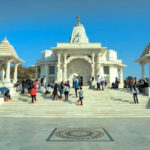Rani Sati Temple, located in Jhunjhunu, Rajasthan, is a significant pilgrimage site dedicated to Rani Sati, a symbol of feminine bravery and devotion. The temple is known for its unique story rooted in Rajput history, where Rani Sati, also known as Narayani Bai, performed sati, the ancient practice of self-immolation, after her husband’s death in battle.
The temple complex, built in white marble, showcases exquisite architecture with intricate carvings and beautiful paintings depicting mythological scenes. It houses the main shrine of Rani Sati along with 13 smaller temples dedicated to other deities, creating a serene and spiritually enriching atmosphere.
Every year, thousands of devotees visit the temple, especially during the auspicious occasion of Bhado Amavasya, when a grand fair is organized. The temple does not have any idol of a female deity, but instead, a trident is worshipped, symbolizing Rani Sati’s power and strength. The Rani Sati Temple stands as a testament to the valor and devotion of women in Indian culture, attracting visitors with its historical significance and architectural beauty.

History of Rani Sati Temple, Jhunjhunu
The Rani Sati Temple in Jhunjhunu, Rajasthan, has a fascinating and poignant history that intertwines with the valorous Rajput traditions. The temple is dedicated to Rani Sati, also known as Narayani Bai, whose story is a legend of courage and devotion.
According to the legend, Narayani Bai was the wife of Tandhan Das, a merchant and warrior. Tandhan Das died in a battle defending their honor, and in her profound grief and determination to join her husband in the afterlife, Narayani Bai decided to commit sati, the ancient practice of self-immolation. This act was seen as a demonstration of ultimate loyalty and courage. Her self-immolation took place around the 13th century, and she became revered as Rani Sati.
The temple was constructed to honor her sacrifice and to celebrate her spirit. Over the centuries, the temple has been rebuilt and expanded, reflecting the devotion and respect of her followers. The current structure of the temple is a beautiful example of Rajasthani architecture, featuring intricate marble work and ornate designs.
The Rani Sati Temple complex includes the main temple, where a trident symbolizes Rani Sati instead of an idol, and 13 smaller temples dedicated to other deities. This unique feature underscores her strength and power, drawing thousands of devotees annually.
The temple’s history is also marked by the celebration of Bhado Amavasya, a significant festival held in her honor, attracting devotees from across the country. This day commemorates Rani Sati’s sacrifice with grand rituals and festivities.
Thus, the Rani Sati Temple not only stands as a place of worship but also as a monument celebrating the valor, sacrifice, and enduring spirit of Rani Sati, a figure who continues to inspire many.

Things To Do In Rani Sati Temple
Visiting the Rani Sati Temple in Jhunjhunu offers a blend of spiritual, cultural, and historical experiences. Here are some activities to consider during your visit:
Temple Darshan: Pay homage at the main shrine dedicated to Rani Sati and absorb the serene spiritual atmosphere. Observe the unique trident symbol that represents Rani Sati instead of a traditional idol.
Explore the Architecture: Marvel at the intricate marble work and detailed frescoes that adorn the temple. The exquisite architecture and carvings reflect the rich cultural heritage of Rajasthan.
Attend Aarti: Participate in the daily aarti (prayer ceremony), especially the morning and evening aartis, which are profoundly spiritual and uplifting experiences.
Visit the Smaller Shrines: The temple complex includes 13 smaller temples dedicated to various deities. Take time to visit these shrines and appreciate the diverse representations of divine figures.
Meditation and Reflection: Find a quiet corner in the temple complex to meditate or simply reflect. The peaceful ambiance makes it an ideal spot for introspection and relaxation.
Historical Insights: Learn about the historical significance of Rani Sati and the practice of sati in Rajput culture. The temple often has guides or informational plaques detailing the story and legacy of Rani Sati.
Cultural Events: If visiting during Bhado Amavasya or other festival times, participate in the special events and fairs. These occasions offer a glimpse into local traditions and vibrant cultural practices.
Enjoy Local Cuisine: Sample traditional Rajasthani food at nearby eateries to complement your cultural experience.
Photography: Capture the beautiful architecture, vibrant paintings, and serene environment of the temple to cherish your visit. Remember to be respectful of the worshippers and the sacredness of the site while taking photos.

Places To Visit Near Rani Sati Temple
Jhunjhunu, a town rich in heritage and culture, offers several interesting places to visit near the Rani Sati Temple. Here are some notable attractions:
Khetri Mahal: Also known as the Wind Palace, this magnificent structure is an excellent example of Indo-Islamic architecture, featuring open galleries and intricate arches.
Sethani Ka Johara: A beautiful and well-maintained stepwell built in the 19th century, it serves as a historic reservoir and a fine example of Rajputana architecture.
Modi and Tibrewala Havelis: These grand havelis showcase stunning frescoes and murals that reflect the rich cultural heritage of the Shekhawati region.
Badalgarh Fort: This fort offers panoramic views of the town and is known for its historical significance and robust construction.
Jhunjhunu Fort: A majestic fort with a blend of Rajput and Mughal architecture, it provides a glimpse into the town’s regal past.
Mertani Baori: An ancient stepwell that exhibits intricate designs and served as an essential water source in earlier times.
Kanoriya Haveli: Famous for its intricate carvings and vibrant frescoes, it is a fine example of the artistic excellence of the Shekhawati region.
Aath Havelis: A group of eight havelis known for their elaborate frescoes and detailed architecture, offering a fascinating insight into the local heritage.
These attractions, each with its unique historical and architectural significance, make Jhunjhunu a captivating destination for visitors.
How to Reach Rani Sati Temple
Reaching the Rani Sati Temple in Jhunjhunu is quite convenient as the town is well-connected by road, rail, and air. Here are the various ways to reach the temple:
By Air: The nearest airport to Jhunjhunu is Jaipur International Airport, located about 190 kilometers away. From the airport, you can hire a taxi or take a bus to reach Jhunjhunu. The journey by road from Jaipur to Jhunjhunu takes approximately 3-4 hours.
By Train: Jhunjhunu has its own railway station, which is well-connected to major cities like Delhi, Jaipur, and Bikaner. Regular trains operate to and from these cities. From the railway station, you can take a taxi, auto-rickshaw, or local bus to reach the Rani Sati Temple, which is about 3 kilometers away.
By Road: Jhunjhunu is well-connected by road with major cities in Rajasthan and neighboring states. You can drive or hire a taxi from cities like Jaipur, Delhi, or Bikaner. Additionally, state-run and private buses operate regularly from these cities to Jhunjhunu. Once you reach Jhunjhunu bus stand, the temple is a short ride away by local transport.
Local Transport: Within Jhunjhunu, you can easily find auto-rickshaws, cycle rickshaws, and taxis to reach the Rani Sati Temple. The temple is a popular destination, so local drivers are well-acquainted with its location.








